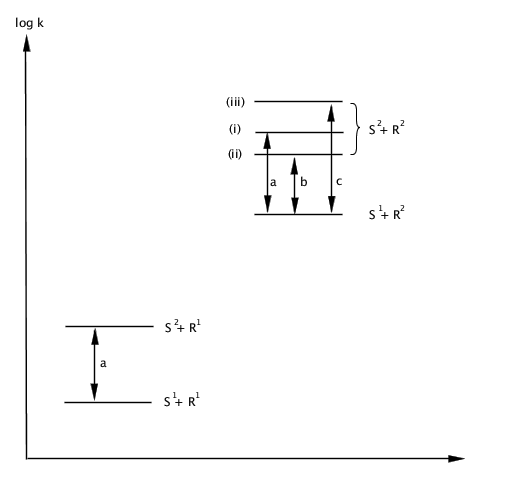https://doi.org/10.1351/goldbook.R05186
This idea may be expressed loosely as: the more @R05180@ a @R05190@ is, the less selective it is. Consider two substrates \(\text{S}^{1}\) and \(\text{S}^{2}\) undergoing the same type of reaction with two reagents \(\text{R}^{1}\) and \(\text{R}^{2}\), \(\text{S}^{2}\) being more reactive than \(\text{S}^{1}\), and \(\text{R}^{2}\) more
With the positions of (\(\text{S}^{1}+\text{R}^{1}\)), (\(\text{S}^{2}+\text{R}^{1}\)) and (\(\text{S}^{1}+\text{R}^{2}\)) fixed, there are three types of positions for (\(\text{S}^{2}+\text{R}^{2}\)). In position (i) the @S05563@ of \(\text{R}^{2}\) for the two substrates, measured by \(a\), is the same as the @S05563@ of \(\text{R}^{1}\) for the two substrates, also \(a\). In position (ii) the @S05563@ of \(\text{R}^{2}\) for the two substrates, measured by \(b\), is less than the @S05563@ of \(\text{R}^{1}\) for the two substrates, i.e. \(b < a\). It is this situation which is in accord with the RSP. In position (iii) the @S05563@ of \(\text{R}^{2}\) for the two substrates, measured by \(c\), is greater than the @S05563@ of \(\text{R}^{1}\) for the two substrates, i.e. \(c > a\). This situation may be described as @A00381@-RSP. There are many examples in which the RSP is followed, but there are also many examples corresponding to situations (i) and (iii). The RSP is in accord with intuitive feeling and certainly holds in the limiting case when reactivity is controlled by @D01716@. However, the validity of the RSP is a matter of great controversy.
R05186.png
reactive than \(\text{R}^{1}\) in the given type of reaction. The relative reactivities (in log units) for the four possible reactions may notionally be represented as shown in the diagram.With the positions of (\(\text{S}^{1}+\text{R}^{1}\)), (\(\text{S}^{2}+\text{R}^{1}\)) and (\(\text{S}^{1}+\text{R}^{2}\)) fixed, there are three types of positions for (\(\text{S}^{2}+\text{R}^{2}\)). In position (i) the @S05563@ of \(\text{R}^{2}\) for the two substrates, measured by \(a\), is the same as the @S05563@ of \(\text{R}^{1}\) for the two substrates, also \(a\). In position (ii) the @S05563@ of \(\text{R}^{2}\) for the two substrates, measured by \(b\), is less than the @S05563@ of \(\text{R}^{1}\) for the two substrates, i.e. \(b < a\). It is this situation which is in accord with the RSP. In position (iii) the @S05563@ of \(\text{R}^{2}\) for the two substrates, measured by \(c\), is greater than the @S05563@ of \(\text{R}^{1}\) for the two substrates, i.e. \(c > a\). This situation may be described as @A00381@-RSP. There are many examples in which the RSP is followed, but there are also many examples corresponding to situations (i) and (iii). The RSP is in accord with intuitive feeling and certainly holds in the limiting case when reactivity is controlled by @D01716@. However, the validity of the RSP is a matter of great controversy.

See: selectivity